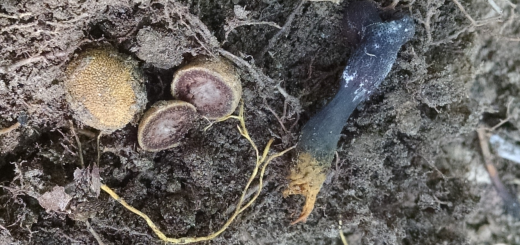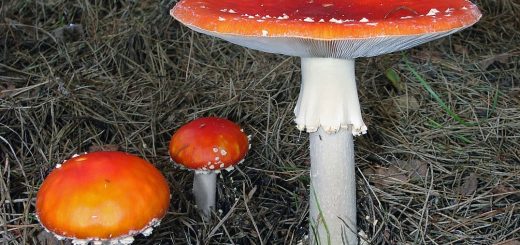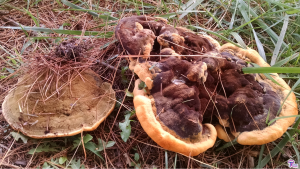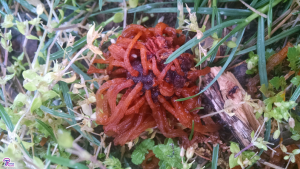#136: Inonotus obliquus, Chaga Mushroom
Chaga (produced by the fungus Inonotus obliquus) is considered by many to be the most potent medicinal mushroom. Its popularity is on the rise and a quick internet search returns mostly websites offering to sell Chaga or sites touting its medicinal benefits. Chaga purportedly has cancer-fighting properties, stimulates the immune system, reduces inflammation, and prevents aging. The part of the fungus that people use is not quite a mushroom. Instead, it is a sterile conk that looks like a large block of charcoal stuck to a birch tree. This structure can be chopped off the tree, ground up, and steeped in hot water to make a tea. Chaga tea is the usual way to take advantage of the fungus’s medicinal properties.
Chaga is a fairly distinctive growth that can be found on the trunks of trees in the birch family (Betula spp.) and a few other hardwoods. The growths, which can be seen on the tree year-round, are blackened and lumpy on the outside, resembling an irregular lump of heavily-charred wood or a tree canker. These grow fairly large and can reach sizes of 10-40cm (4-16in). They are roughly circular but irregular and deeply cracked. The exterior surface is comprised of a fungal structure called a “pseudoclerotial plate.” This is composed of dead fungal cells that are heavily melanized. Melanin, the compound that makes skin darker, protects the fungus from damaging effects of ultraviolet light. On the interior, Chaga is yellowish-brown with cream-colored venation and has a corky texture. Chaga is difficult to separate from the tree, so most Chaga hunters bring hatchets or chainsaws to remove their prize. The sterile conk will grow back, so removing Chaga presumably does little harm to the fungus or tree when carried out respectfully. Chaga reaches a harvestable size in three to five years and will regrow to this size three to ten years after being harvested. The best Chaga is 25 years old, so all the smaller conks should be left alone.
The purpose of the sterile conk is unclear. I have been told that it is designed to keep the tree’s wound open. This ensures that the fungus has access to fresh air. Normally, a tree would seal up its wounds. Consequently, the fungus would not be able to grow as quickly because it could not effectively carry out aerobic respiration. The sterile conk may also include asexual spores, but it is not clear whether or not these spores can infect new trees.
Chaga conks are not very common. It is estimated that only one in 15,000 birch trees bears Chaga. Actual infection rates may be higher, since other tree species can be infected but do not produce conks. Because of this, many people are unsure of what Chaga actually looks like. There are a number of mushrooms or other structures that can be confused with Chaga. A variety polypores form conks, but these have a regular pore surface on the underside of the mushroom. As a general rule, if you’re not sure whether or not it’s Chaga, it probably isn’t.
I. obliquus also produces a fertile, sexual fruiting body (mushroom), but this happens very rarely. The fungus is most likely to produce a mushroom when a part of its host tree or the entire tree dies. Because this is a rare event, a fruiting body may be produced only once during the fungus’s life. The fruiting body is flat and forms between the bark and the wood. It usually appears around the sterile conk, so the bark can fall off and reveal the mushroom. The mushroom itself is yellowish-brown and characterized by tiny pores. It does not last very long because it is quickly eaten by a variety of insects. This suggests that insects may play a primary role in carrying spores to new hosts.
Chaga can be found in temperate forests across the northern hemisphere, where it parasitizes birch trees and a few other hardwoods, including beech, chestnut, alder, and hornbeam. The fungus causes a white heart rot, meaning that it primarily decomposes lignin in the wood in the center of the tree. Despite the rather broad host range, Chaga conks form only on birch trees. The conks start to form a couple years after initial infection. The infected tree usually lives for about twenty years with the infection before it is weakened so much that it falls over during a storm.
I. obliquus is placed in the phylum Basidiomycota, class Agaricomycetes, order Hymenochaetales, and family Hymenochaetaceae. Its closest relatives are other polypores, most of which grow on trees and are parasitic or saprobic. Other common names for Chaga include “Clinker Polypore” and “Birch Canker Polypore.”
The use of Chaga as a medicinal mushroom was popularized by people in Siberia. There, people used it to treat tuberculosis, lung and stomach diseases (including cancer), and general pain. Chaga was thrust onto the international stage with the publication of a book called The Cancer Ward, written by Aleksandr Solzhenitsyn. The main character of the book gets cancer but is cured by Chaga tea. Although a work of fiction, Solzhenitsyn used many elements from his own life, including a battle with cancer.
Since its introduction to the wider world, Chaga has become one of the most intensively-studied medicinal mushrooms. I am not aware of any clinical trials involving Chaga, but many studies have analyzed the fungus and identified various beneficial compounds. These compounds include a number of antioxidants, which prevent DNA damage and as a result could protect against inflammation, certain cancers, and signs of aging. Other studies have found that Chaga could treat viral infections, treat tumors and cancers, and give the immune system a boost.
The molecules studied are primarily those that can be extracted from Chaga using hot water. In other words, the molecules can be found in Chaga tea. Preparation of Chaga is fairly simple. The removed conk is cut into smaller pieces (about 5cm or 2in long) and dried. It can then be stored in a cool, dry place for up to a year. When ready to use, a piece of the Chaga should be ground up, packed into a tea bag, and steeped in hot water to make a tea-like beverage. Steeping Chaga in alcohol or carbonic acid might release a different set of medicinal compounds, but this has not been studied as much.
In addition to medicinal benefits, Chaga can be used as very effective kindling. Chaga is one of the most effective natural kindling materials. The convoluted texture of Chaga allows it to easily catch a spark. Since the fungal material burns slowly, the spark can be transported and used to start a fire with minimal effort. This property can be improved by treating the Chaga with urine. After a few cycles of soaking it with urine and letting it dry, Chaga lights even more easily.
With Chaga growing in popularity, sustainability is a big concern for the industry. Since the sterile conk’s purpose is unclear, it is hard to estimate the environmental impact of the Chaga industry. When Chaga is harvested in such a way that the host tree is damaged, the tree can be exposed to new fungal and insect pathogens. This can hasten the tree’s death, potentially reducing birch populations and making it more difficult for I. obliquus to successfully reproduce. Since there is so much about this parasitic relationship that is unknown, please be respectful when removing or buying Chaga.
As it turns out, Chaga is fairly easy to cultivate using methods similar to those for cultivating other mushrooms. Cultivated Chaga will form a structure similar to the sterile conks it produces in nature, but analysis of the Chaga mycelium shows that it is also suitable for medicinal use. For example, cultivated Chaga mycelium shows about the same levels of antioxidants as wild Chaga. Additionally, Chaga grown in a controlled environment would have fewer contaminants. Wild Chaga likely contains insect debris and may have pollutants that were extracted from the air (especially if it was growing near a road). Contamination is a greater concern for Chaga than for most other foraged mushrooms because of Chaga’s extremely long growing period. While it may not be a perfect solution, industrial cultivation of Chaga should certainly be investigated further.
See Further:
http://www.huffingtonpost.com/paul-stamets/chaga-mushroom_b_1974571.html
http://www.namyco.org/docs/MycoJanFeb06.pdf
http://www.fsl.orst.edu/mycology/PilzPage_files/Pilz2004ChagaReport.pdf
http://www.mushroomexpert.com/taxonomy.html (taxonomy)









![#011: Characteristics of Kingdom Fungi [Archived]](https://www.fungusfactfriday.com/wp-content/themes/hueman/assets/front/img/thumb-small-empty.png)



1 Response
[…] are most likely to confuse Black Knot with Chaga (Inonotus obliquus, FFF#136), especially when looking at large galls on the trunk. This happens so frequently I’ve lost […]